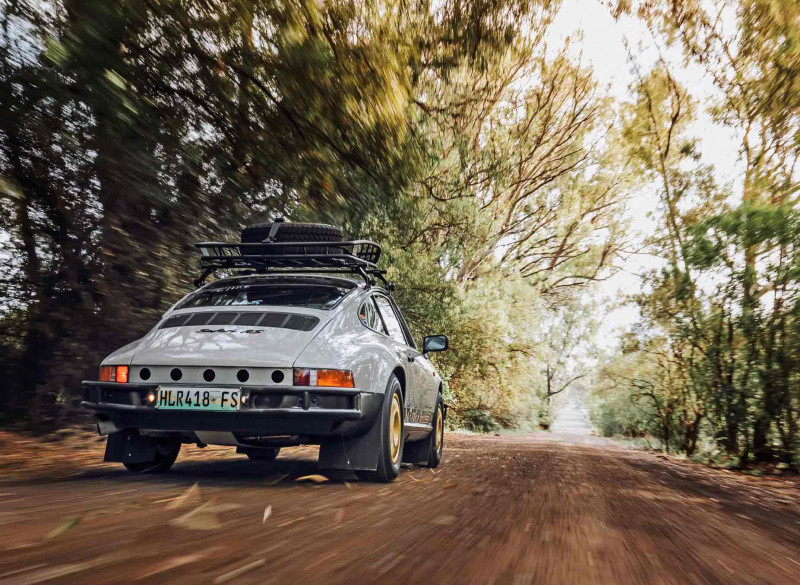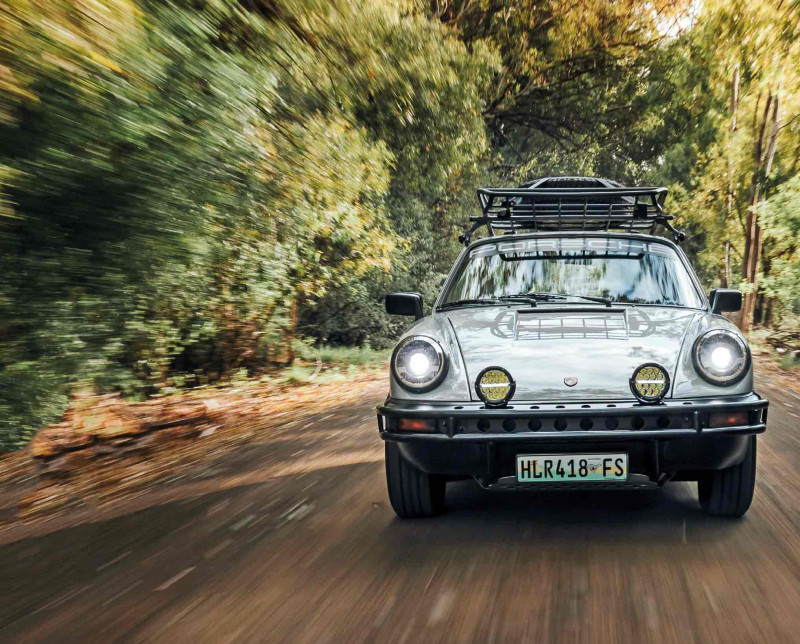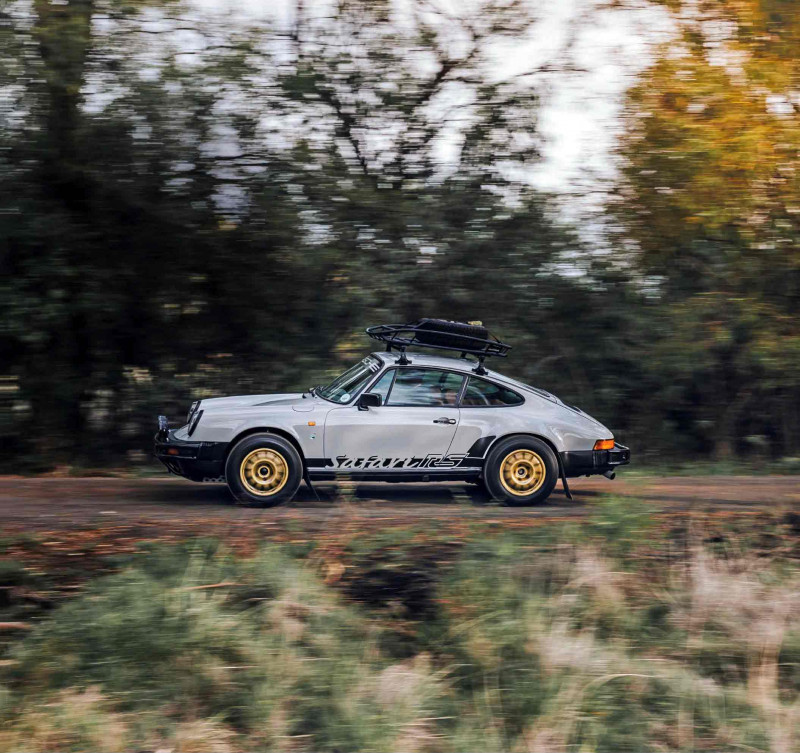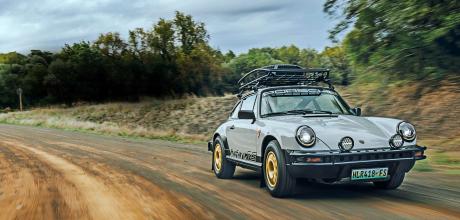1982 Porsche 911 SC “Safari RS”
In the heart of South Africa, a 911 collector decided not to simply restore his SC to be used as a daily, but to upgrade it to be taken far off the beaten track. Written by Wilhelm Lutjeharms Photography by Peet Mocke.
Off the Beaten track
SC on safari! Full off-road test in the SC rebuilt for riding rough
It feels weird. I’m driving a 911 on a gravel road… and at some speed! In 15 years of driving these cars, this has never happened. 911s are about grip and handling, but when the tarmac ended and I hit the gravel, in this car I could just nonchalantly continue driving. I quickly realise how much fun it is, as well as how practical a car such as this one can be.

The owner of this 911 is Douw Raimondo. He hails from Bloemfontein, the capital city of the Free State province, right in the heart of South Africa. His journey with Porsche 911s has taken many turns over the years, and many cars came and went. In recent years he has actually moved away from only owning original 911s to having cars that are very neat, yet not original.
This example ticks that box, but what makes this one more special is that it is an idea that had been germinating in his mind for some time. “I searched hard for an affordable donor to do this project with. I eventually found one outside Cape Town. As the engine needed a rebuild, I got the car for a good price and sent it to Porsche Centre Cape Town for a full assessment. The result was better than I expected. There was no rust, it had never been in an accident and it was a matching numbers car.
“I wanted to build a type of 911 rally car that you can venture off the beaten track with”
“I wanted to build a type of 911 rally car that you can venture off the beaten track with. The idea was that my wife and I pack the car, put the bicycles on the roof and go away for a weekend. Within a year the car was done, perfectly built by Tim Abbot at Porsche Master Craftsman outside Johannesburg. “To kick off the project, when I went to Tim and asked him to build me this car I also gave him an entire build sheet, a thick folder that contained all my ideas. These included photos and ideas I’d collected over a period of time. I had put a lot of research into this car.”

Raimondo had some wild ideas for the suspension, but Abbot said that for how he wants to use the car, and setting the suspension on its highest setting with the standard Bilstein dampers will do the trick. The only mechanical upgrade has been an Elephant Racing tower strut brace at the front. Inside, Raimondo wanted the car to be relatively luxurious. To this end he has fitted a decent sound system and upgraded the air conditioning by fitting a booster system. Raimondo confirms that this setup manages admirably with the hot summer days here in South Africa.
Understanding and appreciating fully original cars, Raimondo points out that the SC can easily be converted back to the way it was when it left the factory, should the need arise. “The car was repainted and I did a few minor modifications. An electronic ignition module was installed, I replaced the chain tensioner and the wiring was completely redone. I replaced many of the bulbs with LED lights, including even the back lighting for the dashboard and dials. The headlights I imported from the USA and are the same units used by Singer Vehicle Design. They are truly impressive. If you drive at night with these and the spot lights switched on you can see clearly far ahead of you. The gold-coloured Braid Acropolis wheels were also imported from the USA, some of the best in the industry and in terms of colour complements the crayon hue of the body.

“When I bought the car it had around 138,000 miles on the odo, but the engine required a full rebuild. Furthermore, the spotlights were added and Tim hand made the bumpers as we could not find someone able to manufacture them. A bash plate was installed at the front of the car. There is also another plate at the rear, protecting the engine and gearbox. The result is that the car can really venture off-road. The roof carrier I simply bought from Thule.
“I often drive to Bethlehem and back for business, a 320-mile return trip. Other than that, I’ve taken it to Johannesburg a number of times, which is a 500-mile return journey. The car runs perfectly on the open road. I recently achieved an impressive speed on the GPS, especially considering the negative aerodynamic effect the roof rack has, as well as those heavy wheels. That is not the purpose of the car though, but after having had the car built, obviously one wants to see how it handles and how fast it is. I would classify it as an urban-type rally car. I got a quote for a full KW suspension so one can go faster off-road, but then you also need to fit a roll cage thus making the car much more focused and less versatile, so I decided against going down that route.
“The car didn’t break the bank, which I’m quite happy with. The headlights were very expensive though, but overall, the total project plus the donor car cost me about the same amount as a good 911 SC would trade for at this stage.”
Enough about the project, by now I am itching to drive this unique 911 again. I climb in and turn the key. The engine settles in what is that fairly typical metallic sound from the flat six. I pull off and within a few shifts I am reminded where the gears are and how to handle the 915 gearbox. It has a good mechanical shift action, but it shouldn’t be rushed. The gear knob is a beautifully machined piece, being made from a combination of wood and aluminium – it feels perfect to the touch with every gearshift. Other interior highlights include the pull straps, with the overall combination of brown leather and the black-and-white Houndstooth cloth used for the centre parts of the seats complementing each other extremely well. And in case you were wondering, the luggage compartment is just as neatly trimmed too, with a matching carpet set and brown beading, making it more luxurious and better trimmed than most modern cars.
The increase in the ride height is not immediately noticeable, but as you exit the car, you realise that the action is easier than from a standard 911 SC.
As I leave the tarmac and head onto the gravel stretch, first impressions are very positive, the tyre and suspension combination really absorbing the minor bumps well. There are no fancy suspension parts fitted, but even so I’m impressed with the bump absorption. The view over the bonnet is the same as that of any other air-cooled 911 from the era, except for the pair of spot lights mounted on the front bumper, a quirky visual reminder that this is not your average 911 SC. In the cabin there is still that solid feeling we associate with air-cooled 911s, albeit with a slightly stronger focus on luxury. The beautiful seats are soft and comfortable, but at the same time the side bolsters around my upper legs provide enough support. The three-spoke, Alcantara-clad MOMO steering wheel feels perfect in my hands and feeds much-needed front axle information to the driver.
As one would expect from a rebuilt engine, it feels new and is happy to rev, while also offering enough torque. Before having some fun, I decide to first find out whether the engine will be happy pottering around as low as possible in the rev range. After all, if you really need to drive slowly over challenging surfaces, tractability is an important feature of an engine. The 3.0-litre SC effortlessly obliges. With around 1,000rpm on the rev counter, the drivetrain is happy to tick over and I can easily see myself navigating much trickier terrain with this SC.
Increasing speed again, the engine clears its throat properly as the rev needle passes 4,000rpm. Although the knobbly tyres offer some much-needed grip on gravel, it is also very easy to overcome the grip levels with a prod of the throttle. Use the brake pedal with enthusiasm and the wheels will lock up (although the car still pulls straight) while you can easily have the rear tyres break traction through a corner.
What a fun car this is! Although in terms of engineering and design it might be far removed from the factory off-road 911 racers in the ’70s and ’80s, it still gives you a glimpse of the 911’s off-road capabilities and what it must have felt like racing the 911 on the world’s rally stages. It is a car that can be used every day, while also easily heading off-road onto any one of the plethora of gravel roads that criss-cross South Africa.
“My dream trip is to head to the Western Cape and do a route along the coast, through the wellknown flower landscapes and then down the Southern part of the coast. The car is not meant to be a garage queen, which is why I use it often for a variety of trips.”
The journey of any 911 enthusiast is an interesting one, and this story is no exception. I, for one, find a car such as this very inviting and can’t think of a better combination of performance, practicality and passion all mixed into one to fully enjoy.
“…it gives you a glimpse of the 911’s off-road capabilities”
LEFT Thule roof rack can carry spare wheels or even bicycles if needed
FAR LEFT Rally-spec tyres and adjustable suspension at its highest setting gives this SC its off-road look.
ABOVE Wood, aluminium, leather and houndstooth are more Monte Carlo than motorsport, but the interior of this SC plays into a requirement for practicality.
Porsche at the Paris-Dakar rally
Porsche has a long history of rallying the 911. However, none is as profound as that of the original and gruelling Paris-Dakar rally. In 1984 Porsche entered this rally for the very first time. Designated the 953, but often referred to as the 911 4x4, Porsche’s first 911 race car was equipped with a developmental all-wheel-drive system that was to be used on its replacement, the 959. The model was short lived as the 959 Paris-Dakar race car was already entered for 1985. The 911 4x4 also had custom suspension and its flat six engine delivered 300bhp while the car tipped the scales at only 1,247kg. Three cars were entered in 1984, of which one was able to take the overall chequered flag, René Metge and Dominique Lemoine being in the cockpit.
This success laid the foundation for Porsche for off-road racing, with three 959s entered in 1985. Sadly none finished due to mechanical failures and crashes. However, in 1986 Porsche achieved a 1st, 2nd and 6th place with its 959, René Metge and Dominique Lemoine again bringing home their car 1st and with 2nd place going to none other than Jacky Ickx and Claude Brasseur. These cars were equipped with the 2.8-litre, flat six, twin-turbo engine developing 400bhp. Part of the reason why the engine delivered only 400bhp is because at times during the race the 959 had to be filled with 86 octane fuel, with a higher octane fuel not being available in the desert.
TECHNICAL DATA
- Model 1982 Porsche 911 SC “Safari RS”
- Year 1982
Engine
- Capacity 2,994cc
- Compression ratio 9.8:1
- Maximum power 204bhp at 5,900rpm
- Maximum torque 267Nm at 4,300rpm
- Transmission 5-speed manual
Suspension
- Front Independent; wishbones; MacPherson strut; torsion bars; hydraulic shock absorbers; anti-roll bar
- Rear Independent; semi-trailing arms; torsion bars; hydraulic shock absorbers; anti-roll bar
Wheels & tyres
- Front & Rear Goodyear Wrangler All-Terrain Adventure, 7x15-inch, 205/70 R15
Dimensions
- Length 4,291mm
- Width 1,626mm
- Weight 1,160kg
Performance
- 0-62mph 6.5 seconds
- Top speed 146mph


